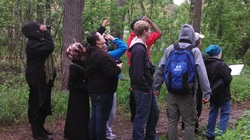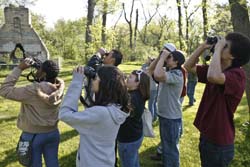Birding Outings
Information about upcoming birding outings will be posted as events are scheduled. In the meantime, read more about one of our past events...

New Birding List Show Eighty Species use Como Woodland
Written by: Deb Robinson
Photo by: Ginger Kopp
The Como Woodland Outdoor Classroom (CWOC) now has a new and improved bird list thanks to the dedicated work of Como Woodland Advisor, Dr. Joan McKearnan, and with financial assistance from CWOC’s long-time project partner, Saint Paul Audubon Society (SPAS).
Murray Jr. High School students and Youth Conservation Corps helped collect the new data. Como Woodland Advisors, Susan Jane Cheney and Ginger Kopp, helped with student data collection outings.
Data collected by Como Park Sr. High School AP students at past spring Field Days were also incorporated into the list as well as bird sightings in the CWOC by local birder, Val Cunningham. Bird survey results from a baseline bird habitat analysis done in 2006 (also funded by SPAS) were compiled with all other sources. All this added up to an impressive 80 bird species sighted in Como Woodland.
Dr. McKearnan’s grant report results to the SPAS states:
Additional observations documented confirmed or probable breeding of 18 species of birds. Eight species were found to be abundant in at least one season. The American Robin was abundant in spring, summer and fall and White-throated Sparrows in spring and fall. The Indigo Bunting may be the most common breeding species in the Como Woodlands.
The birding list surveys revealed that bright-colored spring warblers, like the Blackburnian warblers and American redstarts, used the woodland for a brief migration stopover. Charismatic raptors, like the Cooper’s hawks and Great horned owls, used the woodland to raise families. In the spring, the flutelike song of a Wood thrush might occasionally be heard in the woodland. However, in all seasons, the shrill calls of a Red-bellied woodpecker will certainly heard. Results confirmed that a variety of birds are feeding, breeding, nesting, or resting in our small 17-acre urban woodland.
The considerable time and effort put into data collection and analysis produced more than a simple list for birding in the CWOC (although that is worthwhile goal in itself). The Como Woodland bird list and its research can be used as an educational aid by environmental science classes or used by natural resource professionals for future conservation efforts. An unexpected artistic use for the bird list is in the works for Fall 2014.
Great River School students plan on using this bird list for researching and designing both a new logo and educational poster for the Como Woodland Outdoor Classroom. The diverse disciplines of art and science will come together in this particular project. But this bird list is sure to be put to many other creative and practical uses.
The Como Woodland Advisory Committee hopes that you will find your own use for this birding list. Be sure to let us know what you see in the woodland and your observations will be part of the ongoing research. Get the birding list here!
Written by: Deb Robinson
Photo by: Ginger Kopp
The Como Woodland Outdoor Classroom (CWOC) now has a new and improved bird list thanks to the dedicated work of Como Woodland Advisor, Dr. Joan McKearnan, and with financial assistance from CWOC’s long-time project partner, Saint Paul Audubon Society (SPAS).
Murray Jr. High School students and Youth Conservation Corps helped collect the new data. Como Woodland Advisors, Susan Jane Cheney and Ginger Kopp, helped with student data collection outings.
Data collected by Como Park Sr. High School AP students at past spring Field Days were also incorporated into the list as well as bird sightings in the CWOC by local birder, Val Cunningham. Bird survey results from a baseline bird habitat analysis done in 2006 (also funded by SPAS) were compiled with all other sources. All this added up to an impressive 80 bird species sighted in Como Woodland.
Dr. McKearnan’s grant report results to the SPAS states:
Additional observations documented confirmed or probable breeding of 18 species of birds. Eight species were found to be abundant in at least one season. The American Robin was abundant in spring, summer and fall and White-throated Sparrows in spring and fall. The Indigo Bunting may be the most common breeding species in the Como Woodlands.
The birding list surveys revealed that bright-colored spring warblers, like the Blackburnian warblers and American redstarts, used the woodland for a brief migration stopover. Charismatic raptors, like the Cooper’s hawks and Great horned owls, used the woodland to raise families. In the spring, the flutelike song of a Wood thrush might occasionally be heard in the woodland. However, in all seasons, the shrill calls of a Red-bellied woodpecker will certainly heard. Results confirmed that a variety of birds are feeding, breeding, nesting, or resting in our small 17-acre urban woodland.
The considerable time and effort put into data collection and analysis produced more than a simple list for birding in the CWOC (although that is worthwhile goal in itself). The Como Woodland bird list and its research can be used as an educational aid by environmental science classes or used by natural resource professionals for future conservation efforts. An unexpected artistic use for the bird list is in the works for Fall 2014.
Great River School students plan on using this bird list for researching and designing both a new logo and educational poster for the Como Woodland Outdoor Classroom. The diverse disciplines of art and science will come together in this particular project. But this bird list is sure to be put to many other creative and practical uses.
The Como Woodland Advisory Committee hopes that you will find your own use for this birding list. Be sure to let us know what you see in the woodland and your observations will be part of the ongoing research. Get the birding list here!

Spring into summer from May to July - Field Day birding
Read the full story by Deb Robinson: PDF220k
High school students have been monitoring 14 study plots in the Como Woodland since the Fall Field Day last October. On Spring Field Day this May 23, the students returned to their study plots again to identify species and densities of trees, forbs, lichen colonies, and earthworms. This is a long-term study, and the data the students collect will be used to monitor changes in the woodland during the restoration process. On this field day a new element was added – a bird survey. And the number of bird species sighted that morning was a pleasant surprise . . .
Read the full story by Deb Robinson: PDF220k
High school students have been monitoring 14 study plots in the Como Woodland since the Fall Field Day last October. On Spring Field Day this May 23, the students returned to their study plots again to identify species and densities of trees, forbs, lichen colonies, and earthworms. This is a long-term study, and the data the students collect will be used to monitor changes in the woodland during the restoration process. On this field day a new element was added – a bird survey. And the number of bird species sighted that morning was a pleasant surprise . . .
